Understanding the Foundations of Behavioral Health in Intake Processes
Behavioral health assessments form a cornerstone of effective resident intake procedures, providing essential insights into an individual's mental and behavioral health. These evaluations are integral for tailoring treatment plans, ensuring safety, and facilitating early detection of issues such as mental health disorders, substance use, and trauma histories. As healthcare settings increasingly adopt comprehensive screening approaches, understanding what these assessments entail, their purposes, and best practices becomes vital for providers committed to delivering holistic and personalized care.
Components and Methods of Behavioral Health Assessments
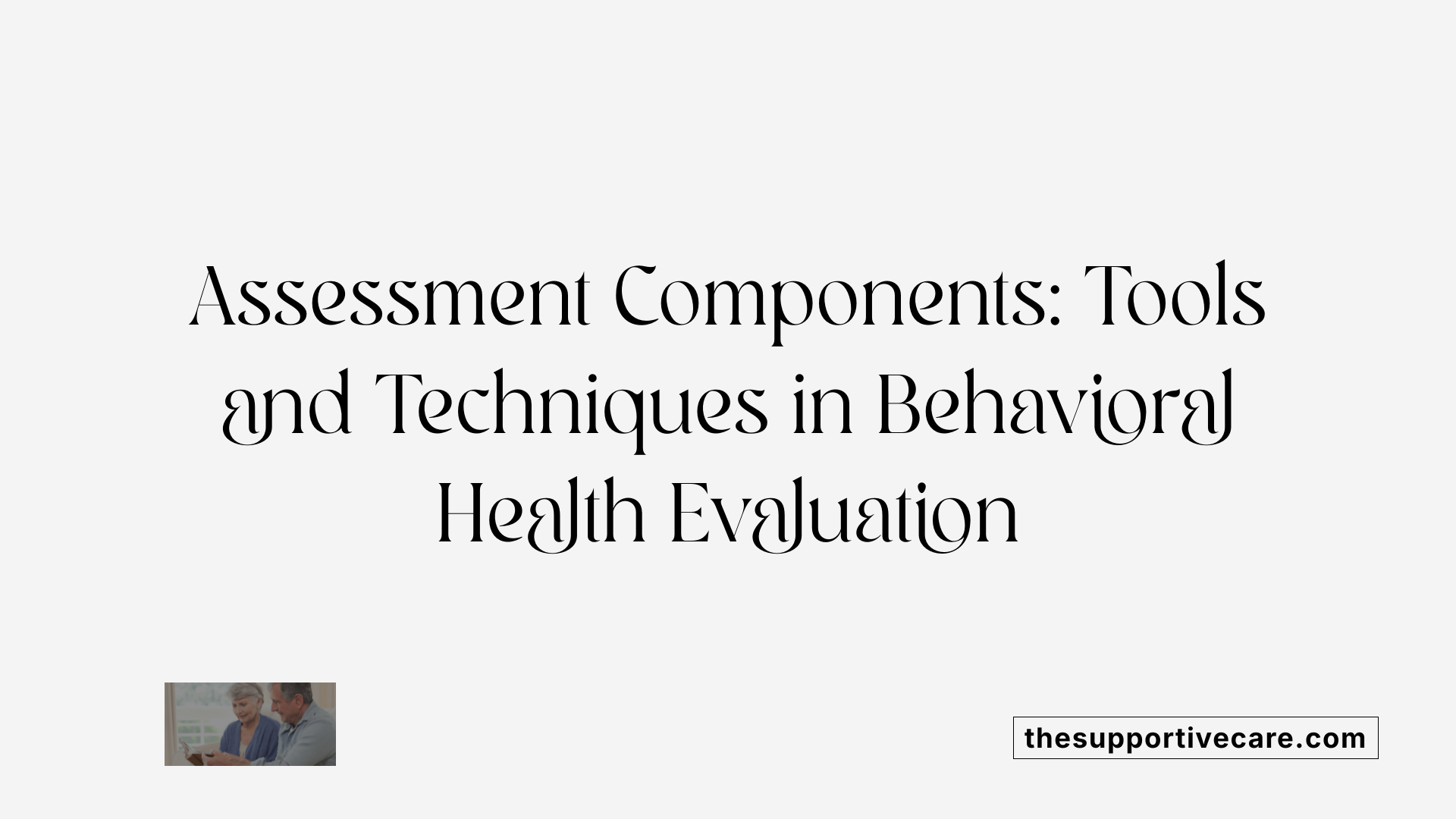
What is included in a behavioral health assessment?
A behavioral health assessment is designed to give a detailed picture of a patient's mental and behavioral health. It combines multiple tools and methods to gather information about psychological well-being.
Primarily, it involves subjective questionnaires that patients complete to report their experiences, symptoms, and behaviors. These self-report tools include well-known instruments such as the PHQ-9 for depression, the GAD-7 for anxiety, the Adult ADHD Self-Report Scale (ASRS), and the SWAN, Vanderbilt, or MDQ scales for conditions like ADHD and bipolar disorder.
In addition to questionnaires, clinical interviews are crucial. These interviews, conducted by trained mental health professionals, delve into the patient's history, symptoms, and functioning. Family or caregiver interviews can also provide collateral information, giving a broader perspective on the patient's behaviors and challenges.
Cognitive assessments form a core part of the evaluation, aiming to objectively measure mental functions like memory, attention, reasoning, and decision-making. Technologies such as the Creyos digital platform enable these tests to be administered efficiently either in clinics or remotely. Creyos's suite integrates seamlessly into electronic health records, supporting clinicians with quick, reliable data.
Physical examinations might be included when necessary, especially to rule out neurological or medical causes of behavioral symptoms. These exams can also help assess overall physical health, which often interacts with mental health.
Lastly, collateral information from family, caregivers, or other medical providers enriches the assessment. This information helps confirm observations, identify patterns, and clarify the context of behaviors.
In summary, a comprehensive behavioral health assessment involves collecting subjective reports, conducting objective cognitive tests, performing physical exams when needed, and gathering collateral insights. This multipronged approach ensures a thorough understanding of the patient's mental health state, guiding diagnosis and personalized treatment planning.
Purpose and Importance of Behavioral Health Assessments During Onboarding
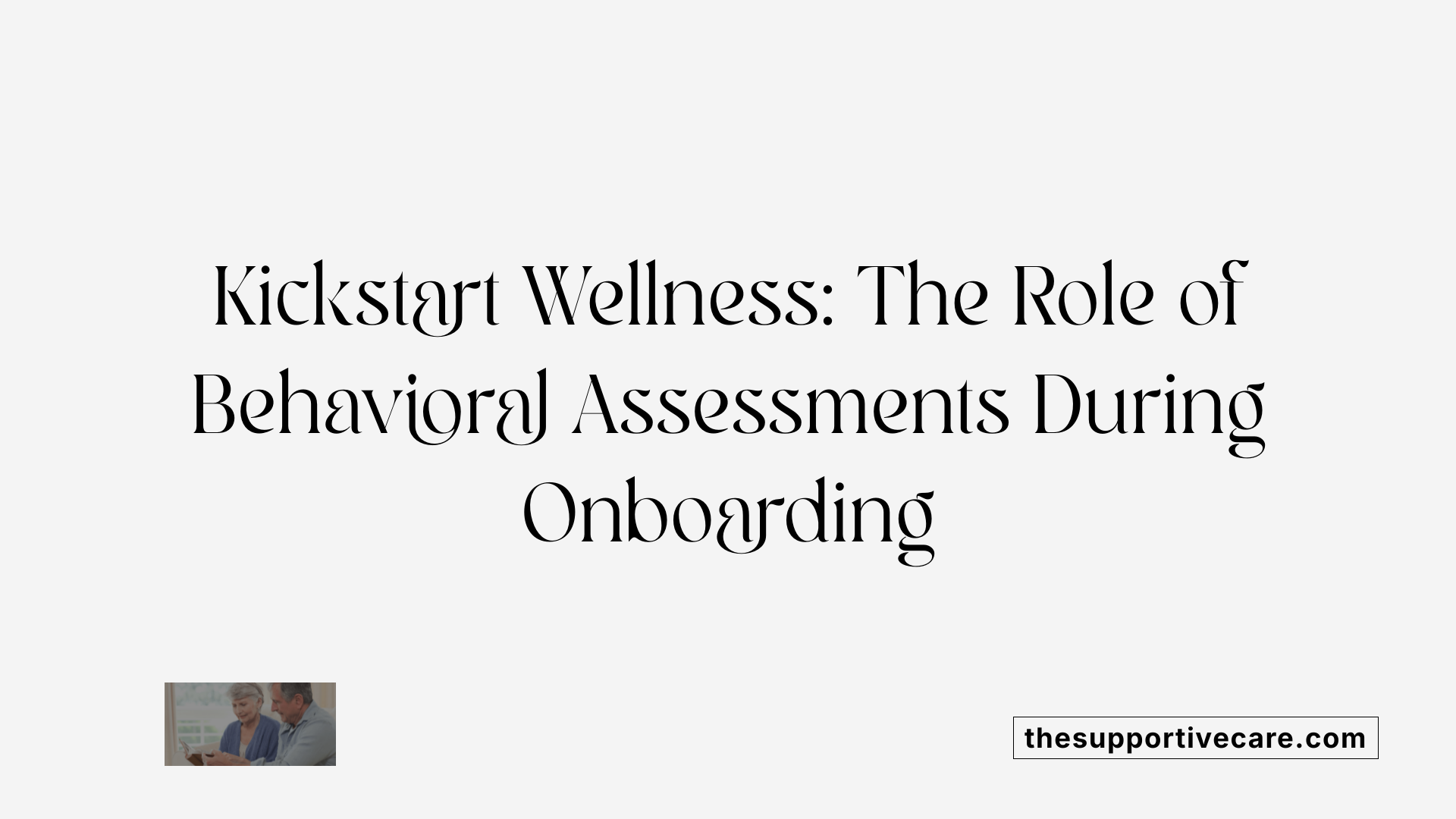
What is the purpose of behavioral health assessments during onboarding?
Behavioral health assessments during onboarding are essential tools used to evaluate a new employee’s mental and emotional well-being as they start their journey within an organization. These assessments help identify existing mental health concerns, behavioral tendencies, and emotional resilience, providing a clear picture of an employee’s ability to cope with workplace stress.
The primary goal is early detection of issues that could impact not only the individual’s performance but also the safety and well-being of colleagues and patients. For example, identifying signs of anxiety, burnout, or trauma-related stress allows organizations to offer targeted support, such as counseling or modifications in job responsibilities.
Additionally, these assessments assist in making informed placement decisions. By understanding an employee’s strengths and challenges, organizations can match roles that align with their capabilities, fostering better job satisfaction and reducing turnover.
Furthermore, behavioral health assessments contribute to developing personalized training and professional development plans. This tailored approach ensures that employees receive the support needed to enhance resilience and effectiveness in high-pressure healthcare settings.
Overall, incorporating behavioral health assessments during onboarding promotes a safer, more supportive, and efficient work environment. They serve as a foundation for ongoing monitoring and support, ensuring that staff members are well-equipped to handle the emotional demands of their roles and maintain overall well-being.
Scope and Depth of Initial Behavioral Health Evaluations
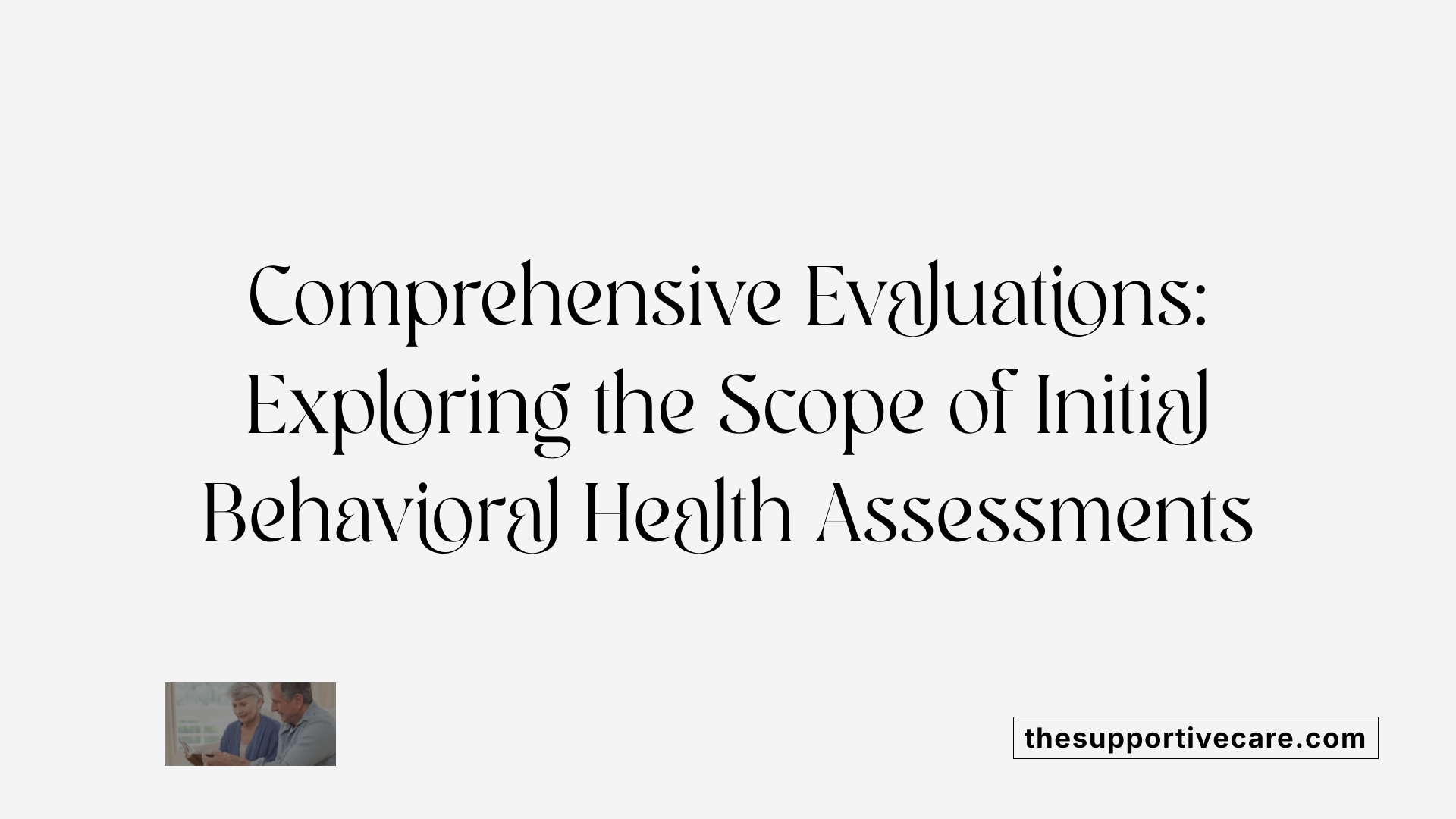
What are the components and scope of behavioral health assessments in initial evaluations?
Behavioral health assessments conducted during initial evaluations are detailed and multidimensional. They serve as the foundation for understanding a patient’s mental and emotional well-being, guiding diagnosis and treatment planning.
A core part of these assessments is a comprehensive clinical interview. This interview explores the patient's personal history, medical background, psychosocial factors, family mental health history, and current symptoms. The clinician seeks to understand the patient’s presenting problems, developmental history, substance use, social support system, and safety risks such as suicidal thoughts or self-harm tendencies.
In addition to interviews, assessments incorporate screening for symptom severity and functional impairments. This includes evaluating mood, anxiety levels, cognitive functions, perception, and insight. Structured questionnaires like the PHQ-9 for depression, GAD-7 for anxiety, or the PCL-5 for PTSD are commonly used to quantify symptoms.
Standardized psychological testing and mental status examinations form another vital component. These objective tools assess cognitive abilities, thought processes, perception, and overall mental functioning. Mental status exams evaluate appearance, speech, behavior, mood, thought content, and perception, providing a snapshot of current mental state.
Collateral information from family members, caregivers, or previous health records can enrich assessment accuracy, especially when patients have difficulty articulating their experiences.
Risk assessments are also integral to initial evaluations. Clinicians evaluate potential for self-harm, harm to others, trauma exposure, and safety concerns. Validated tools such as the PC-PTSD, DAST-10 for substance use, or trauma checklists guide these evaluations, supporting the identification of urgent safety issues.
The scope of initial assessments aligns with the need for a holistic view, considering cultural and developmental factors, which influence presentation and treatment response. Recognizing co-occurring conditions, such as trauma, substance misuse, and physical health issues, enables a more comprehensive care approach.
The assessment process aims not just for diagnosis but also for establishing rapport, understanding the client’s unique context, and informing tailored treatment strategies. Follow-up assessments monitor progress and adapt interventions as needed, reinforcing the dynamic nature of behavioral health care.
In summary, initial behavioral health evaluations encompass detailed interviews, symptom screening, standardized testing, mental health observations, and safety risk appraisals—an essential step toward effective and personalized mental health care.
Integration of Assessments into Healthcare Workflows
How are behavioral health assessments integrated into the intake workflow?
Behavioral health assessments are an essential part of initial patient evaluations and are systematically incorporated into healthcare workflows through the use of standardized assessment tools. During intake, healthcare professionals use questionnaires, structured clinical interviews, and symptom inventories to gather detailed insights into a patient’s mental and behavioral health status.
These assessments not only help highlight current symptoms and risk factors but also consider cultural and individual differences. They are supported by electronic health record (EHR) systems, which enable seamless documentation and facilitate quick access to assessment findings. This integration ensures that all relevant information is consolidated, helping clinicians formulate accurate diagnoses and personalized treatment plans.
Modern technology, such as digital assessment platforms and patient portals, play a critical role. They allow assessments to be conducted remotely via telehealth or online tools, increasing accessibility for patients who cannot attend in-person visits. This flexibility makes it easier for providers to perform evaluations promptly and efficiently.
Ongoing monitoring is also built into the workflow. After the initial assessment, regular reevaluations using validated tools help track symptom progression or remission, guiding treatment adjustments. The use of evidence-based assessments throughout the course of treatment ensures that care remains responsive to each patient’s changing needs.
In summary, behavioral health assessments are embedded into the healthcare process through structured, tech-supported procedures that support comprehensive, continuous, and culturally sensitive care, from initial screening to ongoing monitoring.
Early Identification of Behavioral and Mental Health Issues
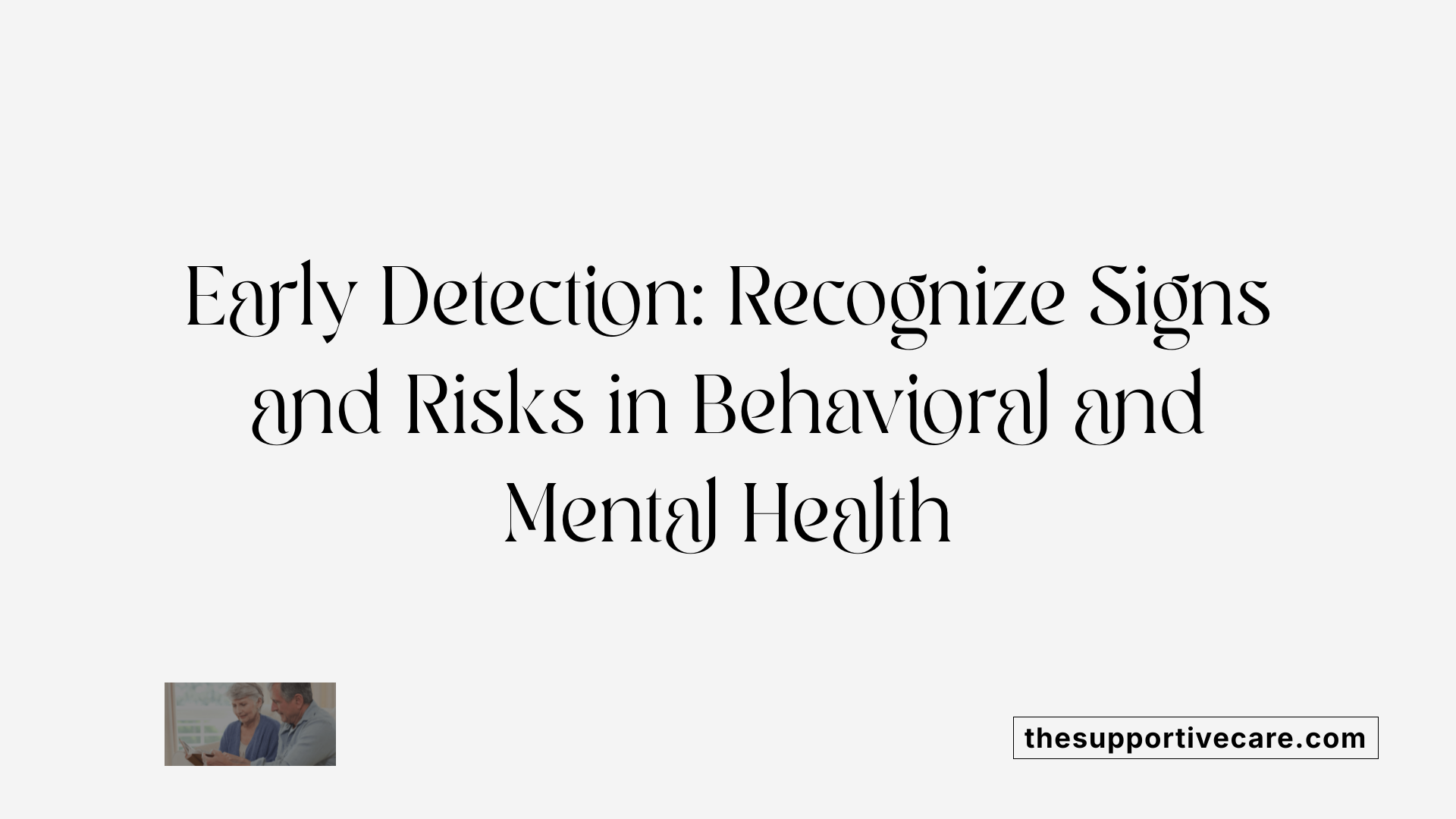
How do behavioral health assessments help in identifying issues during entry?
Behavioral health assessments are vital tools used right at the point of entry into healthcare or treatment programs. They systematically evaluate a person's mental health, substance use, and history of trauma or other behavioral concerns. This process often involves a combination of validated screening questionnaires, clinical interviews, family or caregiver input, and sometimes physical or cognitive assessments.
These assessments help detect potential problems early by identifying symptoms or risk factors that may not be immediately obvious. For example, screening tools like the GAD-7 for anxiety, PHQ-9 for depression, or AUDIT for alcohol use can quickly flag areas needing further attention. Additionally, trauma screening instruments such as the PTSD Checklist (PCL-5) highlight past traumatic experiences that might influence current functioning.
Assessments also consider individual and contextual factors, including social, cultural, and personal history. This holistic approach ensures that signs of mental health issues, addiction, or trauma are recognized in their social and personal contexts. Early detection allows healthcare providers to initiate timely interventions, preventing conditions from worsening and reducing the risk of crises.
Moreover, digital tools like Creyos offer remote assessment options, making it easier to incorporate early screening into routine entry procedures. These tools are integrated into electronic health records, providing comprehensive data accessible for ongoing monitoring.
By identifying issues upfront, behavioral health assessments support personalized care planning. They help determine whether the individual needs immediate intervention, additional assessment, or ongoing monitoring. This proactive approach enhances treatment outcomes, improves resource allocation, and promotes overall well-being.
Early identification also helps in directing individuals toward appropriate services such as counseling, medication management, or specialized programs. It can even uncover underlying trauma or comorbid conditions that might otherwise go unnoticed.
In summary, behavioral health assessments during entry serve as the foundation for early intervention, guiding clinicians toward tailored treatment plans and ensuring individuals receive the right care at the right time.
Best Practices and Guidelines for Conducting Assessments
What are best practices and guidelines for conducting behavioral health assessments as part of resident intake?
Conducting thorough and effective behavioral health assessments during resident intake is crucial for developing personalized care plans and ensuring high-quality treatment. One of the foundational practices is the use of evidence-based, standardized assessment tools. These include clinical interviews, validated questionnaires, and symptom inventories such as the PHQ-9 for depression, GAD-7 for anxiety, or trauma-specific tools like the PTSD Checklist. Incorporating these standardized measures ensures consistency, reliability, and accuracy in evaluating an individual’s mental health status.
Trauma-informed approaches are essential during assessments. This means creating a safe, respectful environment where individuals feel comfortable sharing sensitive information. Professionals should be aware of and sensitive to past trauma or adverse experiences, which may influence how clients respond to questions. Adopting trauma-informed techniques helps build trust and minimizes distress during the assessment process.
Thorough and confidential documentation is another critical aspect. Using structured checklists, digital records, and secure electronic health records (EHRs) allows for comprehensive recording of personal and medical histories, current symptoms, psychosocial factors, and treatment goals. Maintaining strict confidentiality in line with legal and ethical standards protects patient privacy and promotes openness.
A multidisciplinary team approach enhances assessment quality. Involving psychiatrists, psychologists, social workers, and other healthcare providers ensures a well-rounded understanding of the individual’s needs. Engaging clients actively in the process fosters collaboration and shared decision-making, leading to more accurate diagnosis and effective treatment plans.
Furthermore, integrating digital health tools, such as telehealth platforms and online assessment questionnaires (like those provided by Creyos), can improve workflow efficiency. These tools facilitate remote assessments, allow for ongoing monitoring, and support real-time data integration into EHRs. Technology also enables providers to track symptom patterns over time, helping to adjust treatment strategies proactively.
Implementing these best practices aligns with current guidelines and enhances the overall effectiveness of behavioral health assessments, ultimately supporting better patient outcomes and efficient resource utilization.
Documentation, Compliance, and Ethical Considerations
What are the documentation, coding, and compliance considerations for behavioral health assessments?
Detailed and accurate record-keeping is vital in behavioral health assessments. Clinicians must meticulously document all aspects of the assessment process, including the specific tools employed, patient responses, observed behaviors, clinical impressions, and treatment recommendations. This comprehensive documentation not only supports ongoing care but is also essential for legal and billing purposes.
Proper coding is crucial to facilitate insurance reimbursement and ensure compliance with healthcare regulations. Standardized diagnostic codes, such as those from ICD-10, are used to classify mental health conditions and related assessments. Correct coding helps in billing processes, reduces claim denials, and supports accurate statistical reporting.
Confidentiality is a cornerstone of behavioral health practice. Adherence to legal and ethical standards like the Health Insurance Portability and Accountability Act (HIPAA) safeguards patient information. Providers must ensure that all assessment-related data are securely stored, transmitted, and accessed only by authorized personnel.
Cultural and individual sensitivity is also critical during assessments. Clinicians should document considerations related to cultural factors, language barriers, and personal differences, which influence both the assessment process and treatment planning.
Legal responsibilities include mandatory reporting obligations—such as disclosures of imminent harm, abuse, or neglect—that require prompt action and documentation. Clear documentation of such disclosures and actions taken is essential for legal compliance.
In addition to clinical considerations, providers must stay current with evolving guidelines and regulations. This includes understanding insurance coding updates, billing requirements, and compliance standards issued by regulatory bodies.
Maintaining a focus on accuracy, security, and confidentiality in documentation supports appropriate clinical care, insurance processes, and legal protections. Regular audits and staff training enhance compliance and ensure adherence to best practices.
Trauma Screening and Trauma-Informed Assessment Procedures
What is trauma screening and trauma-informed assessment procedures during intake?
Trauma screening is a simple process that involves asking yes/no questions to identify if a person has experienced traumatic events or has trauma-related symptoms. This initial step is crucial in flagging individuals who may need more in-depth assessment and targeted care.
Trauma-informed assessment procedures go beyond basic screening by ensuring evaluations are conducted in a manner that prioritizes safety, respect, and support for the individual. These procedures recognize the profound impact trauma can have on mental health and aim to create a therapeutic environment in which clients feel secure.
By using validated tools like the PC-PTSD, PCL-5, and SPAN, clinicians systematically identify trauma-related issues. These instruments are designed to be sensitive and specific, helping to pinpoint symptoms while acknowledging each person's unique experiences.
The core principles of trauma-informed care include safety, trustworthiness, empowerment, collaboration, and cultural awareness. These principles guide clinicians in conducting assessments that respect personal boundaries and promote a sense of control for clients.
Handling disclosures of trauma sensitively is integral to this approach. Professionals are trained to listen actively, avoid re-traumatization, and ensure that any disclosures are met with empathy and appropriate follow-up practices. This may involve providing information about further evaluation or referral to specialized trauma services.
Overall, trauma screening and assessment are structured to support healing and recovery while respecting the individual's dignity and personal history. Ensuring these procedures are implemented thoughtfully helps foster a foundation of trust and facilitates effective treatment planning.
Trauma Screening Questions and Tools
| Tool Name | Purpose | Features | Implemented In |
|---|---|---|---|
| PC-PTSD | Detect PTSD symptoms after trauma | Brief, screening version of PTSD criteria | Multiple settings including primary care |
| PCL-5 | Measure PTSD symptom severity | Comprehensive, validated for monitoring progress | Clinical and research environments |
| SPAN | Identify PTSD symptoms quickly | Short, easy to administer | Emergency and trauma settings |
These tools aid clinicians in efficiently identifying trauma-related issues and determining the need for further assessment.
Principles of Trauma-Informed Care in Assessment
| Principle | Description | Application |
|---|---|---|
| Safety | Ensure physical and emotional safety | Create a welcoming, non-threatening environment |
| Trustworthiness | Be transparent and consistent | Clearly explain procedures and maintain confidentiality |
| Empowerment | Support client autonomy | Involve the client in decision-making processes |
| Collaboration | Work jointly with clients | Build partnerships for recovery |
| Cultural Competence | Respect diverse backgrounds | Adapt assessments to cultural contexts |
Adhering to these principles ensures assessments are respectful and effective.
Handling Trauma Disclosures Sensitively
When a client discloses trauma, clinicians should listen actively and validate their feelings without judgment. It is essential to maintain boundaries, provide reassurance, and avoid pushing for details that the client isn't ready to share.
Clinicians should acknowledge the courage it takes to disclose trauma and inform clients about next steps carefully, including referrals to specialized trauma services if indicated. Ensuring confidentiality and explaining the limits, especially regarding mandatory reporting, is vital.
Follow-up and ongoing support are crucial components, helping clients feel empowered and supported throughout their recovery journey.
Guidelines for Trauma-Informed Care
- Conduct assessments in a private, comfortable setting.
- Use language that is respectful, clear, and culturally sensitive.
- Avoid re-traumatization by pacing the assessment and giving clients control over the process.
- Integrate trauma awareness into all aspects of care and treatment planning.
- Continuously evaluate and adapt assessment techniques based on the client's responses and progress.
Implementing these guidelines ensures that trauma assessment not only identifies issues but also fosters a foundation for healing and resilience.
Scheduling and Process of Behavioral Health Assessments in Residency Intake
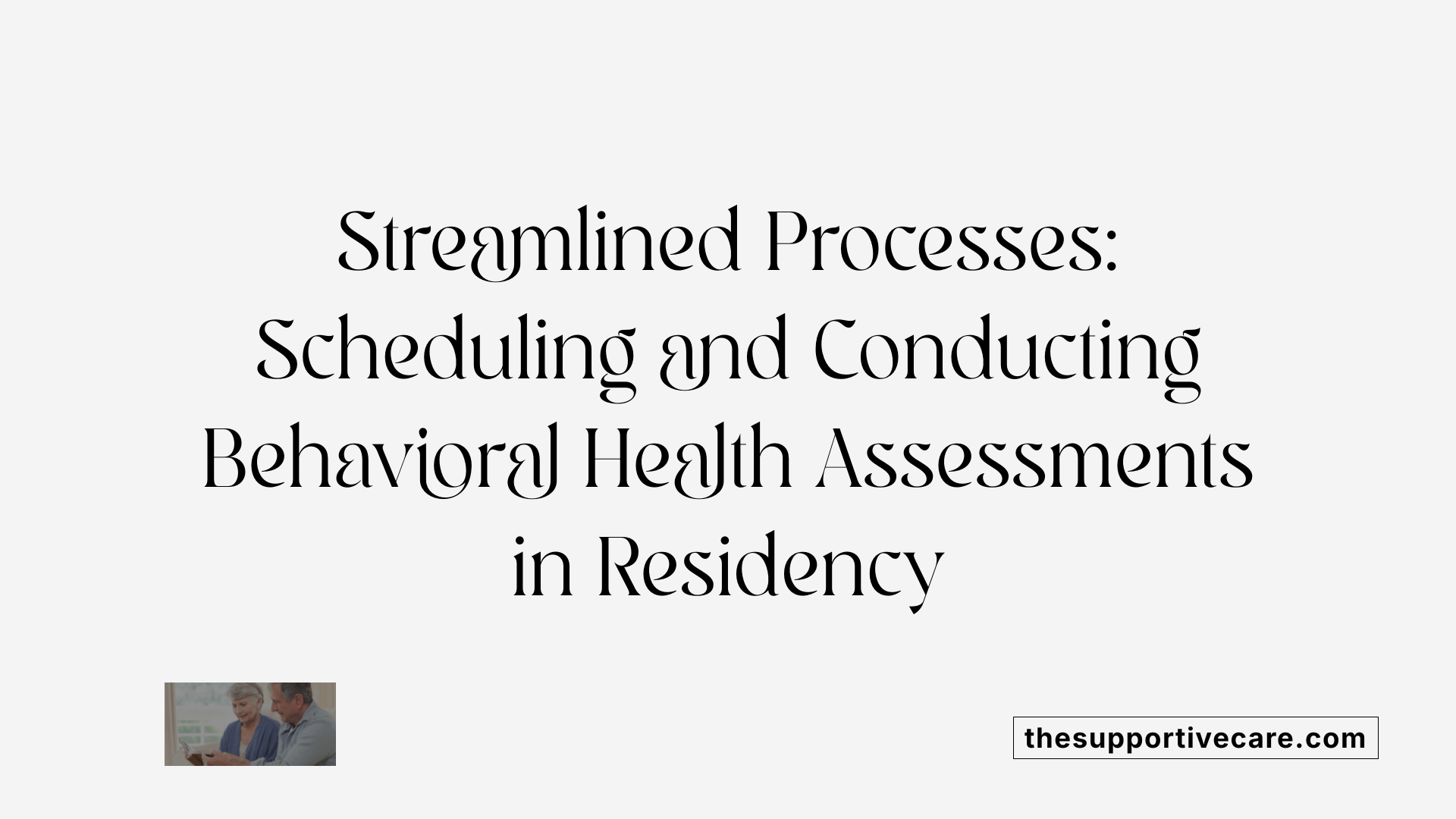
What is the process and scheduling of behavioral health assessments in the intake phase?
The scheduling and process of behavioral health assessments during residency intake are carefully structured to ensure a comprehensive evaluation of each individual's mental health needs. These assessments are typically arranged early in the admission process, often during the initial intake visit or soon afterward. This timing helps clinicians gather critical information upfront to inform diagnosis and care planning.
Prior to the assessment, relevant background data such as medical history, current symptoms, and previous treatment records are collected. Many facilities use digital tools—like online questionnaires or electronic health records—to streamline this process. This preparatory step allows for a more efficient in-person or remote assessment.
The actual assessment involves multiple components:
- Structured interviews conducted by behavioral health professionals.
- Standardized questionnaires that assess specific areas such as mood, anxiety, trauma, and substance use.
- Collateral reports from family members or caregivers, when appropriate, to gain a fuller understanding.
This multi-method approach ensures a balanced view, combining subjective self-report data with objective, clinically validated measures.
Assessment scheduling ensures sufficient time for thorough evaluation without rushing important details. Many programs schedule initial assessments within a few days of admission, with follow-up assessments planned based on individual needs.
Follow-up evaluations are integral parts of ongoing care, scheduled as necessary to monitor symptom changes, re-evaluate diagnoses, or adjust treatment strategies. These reassessments can occur at regular intervals or in response to significant clinical developments, supporting an adaptable treatment process that evolves with the patient's needs.
Throughout the process, documentation is handled digitally—integrating assessment results directly into electronic health records (EHRs)—allowing for seamless communication among care team members. This approach promotes continuity of care and facilitates quick access to critical information.
In summary, behavioral health assessments during residency intake are carefully scheduled and executed to provide a detailed understanding of each resident's mental health landscape. The process involves initial screening, comprehensive evaluations, and periodic re-assessment to ensure that care remains aligned with the patient's evolving needs, ultimately fostering better health outcomes.
Empowering Better Outcomes Through Structured Assessments
Effective behavioral health assessments are pivotal in new resident intake procedures, ensuring that individuals receive tailored, safe, and compassionate care. By integrating standardized tools, trauma-informed practices, and digital technologies, healthcare providers can deliver comprehensive evaluations that inform diagnosis and treatment while respecting individual differences. Adhering to best practices and compliance standards enhances the accuracy, legality, and confidentiality of assessments, ultimately fostering better health outcomes and organizational efficiency. As healthcare continues to evolve, the role of structured behavioral health assessments remains fundamental in creating responsive and resilient care environments.
References
- 10 Behavioral Health Assessments to Identify Patient Needs - Creyos
- What to Expect During Intake | Behavioral Health
- Behavioral Health Services | The MetroHealth System
- Screening and Assessment - Addressing the Specific Behavioral ...
- How to write therapy intake notes (with examples) - Headway
- What is a Mental Health Intake Assessment? - Mentalyc
- Screening and Assessment - Trauma-Informed Care in Behavioral ...
- Mental and Behavioral Health Services | Summa Health



































































































